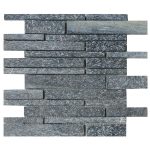The Beauty and Versatility of Cultured River Rock

Introduction
Cultured river rock, also known as manufactured or artificial river rock, is a popular choice for landscaping and interior design projects. This versatile material offers the natural beauty of river rock while providing the benefits of a manufactured product. In this article, we will explore the origins, uses, advantages, and installation of cultured river rock, as well as provide tips on how to incorporate it into your own projects.
Origins of Cultured River Rock
Cultured river rock is a man-made product designed to replicate the look and feel of natural river rock. It is typically made from a combination of cement, aggregates, and pigments that are molded and colored to resemble the textures and colors of natural river rocks. The production process involves pouring the mixture into molds and allowing it to cure before being finished and sealed to enhance its durability and appearance.

Uses of Cultured River Rock
Cultured river rock can be used in a variety of applications, both indoors and outdoors. In landscaping, it is commonly used for pathways, garden borders, water features, and retaining walls. Its natural appearance adds a touch of rustic charm to any outdoor space, while its durability makes it a practical choice for high-traffic areas.
Indoors, cultured river rock can be used for accent walls, fireplace surrounds, and even flooring. Its unique texture and color variations can add visual interest and warmth to any room, creating a cozy and inviting atmosphere. Additionally, cultured river rock is often used in spas and bathrooms to create a soothing and natural aesthetic.
Advantages of Cultured River Rock
There are several advantages to using cultured river rock in your landscaping or interior design projects. One of the main benefits is its versatility – it can be molded and shaped to fit a wide range of design styles and preferences. Whether you prefer a more traditional look or a contemporary design, cultured river rock can be customized to suit your needs.
Another advantage of cultured river rock is its durability. Unlike natural river rock, which can be prone to erosion and fading over time, cultured river rock is designed to withstand the elements and maintain its appearance for years to come. It is also less likely to shift or move, making it a reliable choice for walkways and other high-traffic areas.
In addition to its durability, cultured river rock is also low-maintenance. Unlike Stepping stone edging for garden definition , which requires regular cleaning and sealing to prevent mold and mildew growth, cultured river rock is easy to clean and maintain. Simply wiping it down with a damp cloth or using a mild detergent is usually all that is needed to keep it looking its best.
Installation of Cultured River Rock
Installing cultured river rock is a relatively straightforward process, but it does require some skill and preparation. Before beginning the installation, it is important to prepare the surface by ensuring it is clean, level, and free of debris. Depending on the application, a base layer of sand or gravel may be needed to provide stability and prevent shifting.
Once the surface is prepared, the cultured river rock can be laid out according to the desired pattern or design. It is important to take care when handling the pieces to avoid chipping or cracking them. Depending on the size and complexity of the project, a professional installer may be needed to ensure a seamless and professional finish.
Tips for Incorporating Cultured River Rock
When incorporating cultured river rock into your landscaping or interior design projects, there are a few tips to keep in mind. First, consider the overall style and aesthetic of your space to ensure that the river rock complements the existing design elements. Whether you prefer a more rustic look or a modern feel, there are a variety of colors and textures available to suit your needs.
Additionally, consider the maintenance requirements of cultured river rock when choosing where to install it. While it is low-maintenance compared to natural river rock, it may still require occasional cleaning and sealing to keep it looking its best. Be sure to follow the manufacturer's guidelines for care and maintenance to ensure the longevity of your cultured river rock.
Conclusion
Cultured river rock is a versatile and beautiful material that can enhance the beauty and functionality of any space. Whether used in landscaping or interior design, its natural appearance and durability make it a popular choice among homeowners and designers alike. With its wide range of applications, advantages, and ease of installation, cultured river rock is sure to add a touch of charm and sophistication to your next project.
